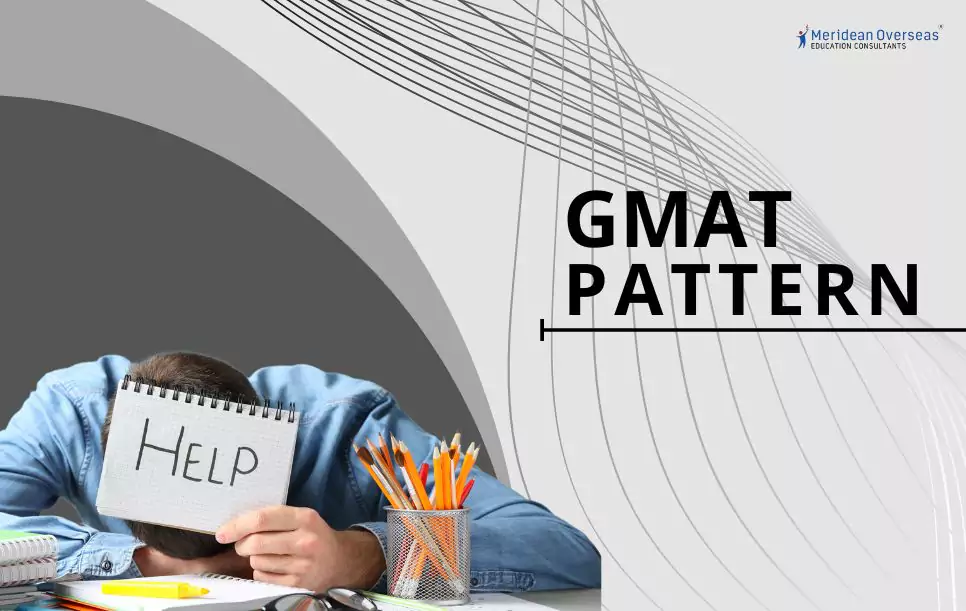
Announcements

Announcements

Many students who are planning to appear for the GMAT exam get confused about the paper pattern. Before beginning any exam preparation, it is critical to understand the exam's pattern and curriculum.
Let us get into the GMAT exam structure in detail. Overall, there are 80 questions in the GMAT pattern, which are divided into four sections: Analytical Writing Assessment (1 Essay in 30 Minutes), Integrated Reasoning (12 Questions in 30 Minutes), Quantitative Reasoning (31 Questions in 62 Minutes), and Verbal Reasoning (36 Questions in 65 Minutes).

GMAT New Pattern 2025 Latest Update
GMAT Exam Pattern 2025
Analytical Writing Assessment for GMAT 2025
Integrated Reasoning for GMAT 2025
Quantitative Reasoning for GMAT 2025
Verbal Reasoning for GMAT 2025
GMAT Test is Computer Adaptive
GMAT Section Order 2025
GMAT Pattern 2025: Test Centre and Online GMAT
FAQs
The GMAT Focus Edition has been released by GMAC. The GMAT Focus Edition material and format differ from the regular GMAT exam. The following table contains information about the GMAT Focus Edition pattern 2025.
|
GMAT Focus Edition Section |
Number of Questions |
Time |
GMAT Focus Edition Score Range |
|
Quantitative Reasoning (QR) |
21 Questions |
45 Minutes |
60-90 (1-point Increment) |
|
Verbal Reasoning (VR) |
23 Questions |
45 Minutes |
60-90 (1-point Increment) |
|
Data Insights (DI) |
20 Questions |
45 Minutes |
60-90 (1-point Increment) |
|
Total |
64 Questions |
2 Hours + 15 Minutes |
205-805 (10-point Increment) |
|
Breaks |
- |
1 Optional Break of 10 Minutes |
- |
The AWA part has been eliminated, and a new component called Data Insights has been established. Furthermore, Sentence Correction (SC) has been eliminated, and Data Sufficiency (DS) is now part of the Data Insights (DI) section.
Students must comprehend the GMAT paper pattern before commencing their GMAT study for the GMAT 2025 exam. The test takes 3 hours and 7 minutes to complete. The GMAT is administered in English and is computer-based. It has a scoring range of 200-800. Each GMAT component has a time limit, which varies depending on the subject. Aside from that, candidates can control their test-taking experience by selecting one of three combinations to take the exam. In the table below, let’s know the GMAT exam pattern.
|
GMAT Exam Section |
No. of Questions |
Time Limit |
GMAT Question Type |
GMAT Score Range |
|
Analytical Writing Assessment |
1 Topic |
30 minutes |
Analysis of an Argument |
0-6 (0.5-point increments) |
|
Integrated Reasoning |
12 questions |
30 minutes |
|
1-8 (1-point increments) |
|
Quantitative Reasoning |
31 questions |
62 minutes |
|
6-51 (1-point increments) |
|
Verbal Reasoning |
36 questions |
65 minutes |
|
6-51 (1-point increments) |
|
Total |
80 questions |
3 hours 7 minutes |
- |
200 - 800 |
Read, more: GMAT Syllabus 2025
The Analytical Writing Section of the GMAT exam evaluates the candidate's critical thinking and communication skills. The candidate is expected to examine and critique a particular argument. Typically, the issues are of general interest. This section evaluates the candidate's ability to organise his or her thoughts and use the provided evidence to support their point of view.
In the Integrated Reasoning Section of the GMAT, candidates must assess and evaluate the information offered in various formats in this section. This section's questions will test your quantitative and linguistic abilities.
Multi-source reasoning: you must compare, interpret, or apply information offered in tables, graphs, diagrams, written passages, and other visual representations in these problems.
Table analysis: This type of question requires candidates to determine statistics, ratios, probabilities, or proportions, among other things, from a provided spreadsheet-like table.
Graphics interpretation: There will be multiple-choice questions based on presented bar graphs, bubble graphs, and line graphs that must be answered.
Two-part analysis: in these questions, a candidate must assess trade-offs, compute proportions, and select responses that will be provided in tabular style.
The Quantitative Reasoning section of the GMAT assesses candidates' abilities to examine facts and draw conclusions based on reasoning skills. Below are some types of questions asked in quantitative Reasoning:
Algebra: Inequalities, equations, functions, exponents, and absolute values are all covered in algebra.
Geometry: It includes the following concepts: circles, lines and angles, solids, coordinate geometry, and polygons.
Arithmetic: It includes the following topics: ratio and proportion, fractions, decimals, percentages, discrete probability counting methods, and sets.
Word Problems: Time and work, rate, simple and compound interest, discounts, profit and loss, data interpretation, measurement challenges, and geometry questions are all word problems.
This portion assesses candidates' abilities to comprehend written material, analyse arguments, and correct written material to conform to standard English.
Reading comprehension: In these questions, you need to refer to a piece of up to 350 words and answer questions about the primary idea, supporting ideas, context, style, tone, etc.
Critical reasoning: In these questions assess a candidate's ability to evaluate arguments and formulate/evaluate a plan of action.
Sentence Correction: These concerns are classified as agreement, grammatical construction, logical predication, parallelism, idiom, verb form, and rhetorical construction.
Now, let’s discuss how the GMAT test is computer-adaptive. The Verbal Reasoning and Quantitative components of the GMAT format are computer-adaptive out of the four sections of the GMAT format. It signifies that the test's difficulty level varies depending on the test taker's competence. This feature enables the test to analyse the candidate's ability. This is why business schools rely on GMAT test scores to admit applicants.
The first question that pops up on the screen, whether in the Quantitative or Verbal Sections, is of medium difficulty. As the test taker moves through the questions, the computer scores the answers and utilises them with your comments to determine the following question. The next question will be easier if you get your first response wrong. If you correctly answer the second question, the next question will be more difficult. This approach is repeated until the candidate's ability in that subject is appropriately assessed.
As a result, if you continue to answer GMAT questions properly, you will receive tougher questions and score higher. If you keep answering the questions incorrectly, you will continue to earn simpler questions, but your score will be lower.
You will be given questions of average difficulty at the outset of the GMAT exam; therefore, getting them correct is quite important. If you properly answer the first 10-15 questions, your GMAT score will be in the higher range. Because the system utilises the test taker's answers to choose the next question, they are not permitted to return to amend their answers. As a result, it is important to provide accurate responses because you will not be able to edit them afterwards.
GMAC introduced Select Section Order in July 2017, allowing students to customise their GMAT exam experience by allowing them to choose the section order they want to use during the exam. As a result, you have control over your test-taking experience. Candidates can now select one of three part ordering alternatives for the exam:
Analytical Writing Assessment, Integrated Reasoning, Quantitative, Verbal
Verbal, Quantitative, Integrated Reasoning, Analytical Writing Assessment
Quantitative, Verbal, Integrated Reasoning, Analytical Writing Assessment
|
GMAT Section Order |
||
|
Order 1 |
Order 2 |
Order 3 |
|
Analytical Writing Assessment |
Verbal Reasoning |
Quantitative Reasoning |
|
Integrated Reasoning |
|
|
|
8-min break (optional) |
||
|
Quantitative Reasoning |
Quantitative Reasoning |
Verbal Reasoning |
|
8-min break (optional) |
||
|
Verbal Reasoning |
Integrated Reasoning |
Integrated Reasoning |
|
|
Analytical Writing Assessment |
Analytical Writing Assessment |
QUICK TIP: Candidates are recommended to take the GMAT adaptive mocks in order to choose which GMAT component they should focus on throughout the exam. Such techniques can only be created by taking several GMAT practice examinations.
The table below compares GMAT pattern 2025 for the GMAT exam taken at a test centre with the GMAT exam taken online:
|
Head |
GMAT Pattern for Test Centre |
GMAT Pattern for Online Exam |
|
Pattern & Sections |
|
|
|
Scoring |
|
|
|
Total Duration |
3 hours + 7 minutes |
3 hours + 7 minutes |
|
Breaks |
2 breaks of 8 minutes each (optional) |
2 breaks of 8 minutes each (optional) |
|
GMAT Exam Fees in India |
$275 |
$300 |
|
Attempts |
|
|
|
Validity |
5 years |
5 years |
|
Score Report Availability |
|
|
|
Appointments |
|
|
|
Scratch Work |
5-page laminated booklet and two dry-erase markers |
Physical whiteboard, online whiteboard, or both |
|
Score Sending |
The first 5 complimentary GMAT score reports will be sent to institutions that you choose on the day of your GMAT exam |
The first 5 complimentary GMAT score reports can be sent within 48 hours of receiving the official score |
|
Additional Score Report (Beyond the First Five) |
$35 each |
$35 each |
Overall, understanding the GMAT exam pattern is important for anyone aspiring to pursue a graduate business degree. From the unique format to the diverse question types and time constraints, being well-versed in these aspects is key to navigating the test successfully. As you prepare for your GMAT, remember that a strategic approach, time management, and comprehensive exam structure knowledge will help you perform at your best.
1: Does GMAT have a sectional time limit?
Yes, the GMAT exam has a sectional time limit. The Quantitative Reasoning section consists of 62 minutes, the Verbal Reasoning section consists of 65 minutes, the Integrated Reasoning section consists of 30 minutes, and the Analytical Writing Assessment consists of 30 minutes.
2: Which section of the GMAT is most difficult?
The most difficult section of the GMAT is Quantitative Ability. The quantitative ability questions demand you to use mathematical principles and solve problems. This portion requires high maths and quickness because you only have 75 minutes to complete it.
3: Is a calculator allowed in GMAT?
Calculators are permitted only during the GMAT's Integrated Reasoning part. They are not permitted to participate in the Quantitative Reasoning section. You should not bring your calculator; one will be given. Whereas for the new format of GMAT, calculators are permitted only in the new Data Insights portion of the GMAT Focus Edition.
4: Can I choose the order in which I take the sections on the GMAT Exam?
Yes, you can take the GMAT Exam components in any sequence you want. However, once a portion is begun, it must be finished before proceeding to the following section.
5: Is there any negative marking in the GMAT section?
The GMAT Exam does not have negative markings. Because the GMAT Exam is computer-adaptive, the difficulty level of the questions will alter depending on the test-taker's performance, so candidates are encouraged to answer all questions.

Contact MOEC Experts for Study Abroad Guidance!

MOEC